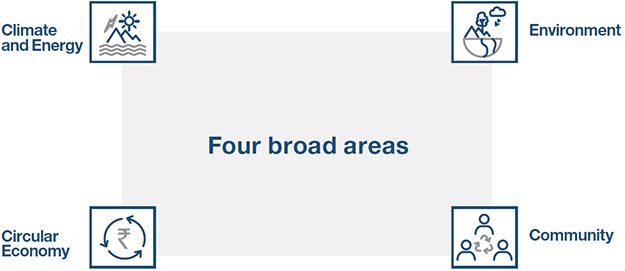
Reporting scope, boundary and the Company’s value chain
The Integrated Report for 2020 covers information on our business segments in India, along with associated activities that enable short-, medium- and long-term value creation. The report contains detailed reference to sustainability initiatives undertaken by Ambuja Cement to address the material issues identified in an extensive stakeholder engagement and due diligence exercise carried out during early 2018. The engagement exercise included all relevant stakeholder groups and the topic boundary was defined with high-importance material topics. The aspect boundaries and content have been defined using reporting principles prescribed in the GRI Standards. The report covers all operations and businesses of Ambuja Cement that fall under its direct operational control. However, we welcome our readers’ valuable feedback to further enrich the quality of our report.

Exclusion: The subsidiaries and JVs, and channel partner/ dealer networks beyond our direct operational control.
Assurance statement
The report is externally assured as per AA 1000 Assurance Standard. The organisation, employees and the assurance providers are independent agencies.
Third-party assurance statement
The non-financial disclosures of Ambuja Cements Limited’s
Integrated Report have been assured by TUV India Private
Limited. The assurance report issued by TUV India Private
Limited can be found on
Sustainability commitment
Aligned with the Sustainable Development Ambition 2030 of LafargeHolcim, we are working towards addressing challenges in:

Our capitals
We depend on various relationships and resources to conduct our business, as defined under the seven capitals.
Financial capital
Access to cost-effective funds such as equity, debt and reinvestment—for sustaining and creating value across all capitals
Read MoreManufactured capital
Wide network of integrated manufacturing units, grinding units, mining assets, along with supporting infrastructure for logistics, warehousing and sales
Read MoreIntellectual capital
Our deep industry knowledge finds reflection in the way we innovate, the technology and knowhow that evolved over the years at Ambuja Cement, and robust R&D systems that we have put in place
Read MoreNatural capital
We use natural resources such as limestone, coal and other minerals. Air, water, energy, land and biodiversity are either used directly or impacted by the operations
Read MoreSocial capital
Our social capital includes the way we manage relationships with our society
Read MoreRelationship capital
Our relationship capital includes the way we manage relationships with our key stakeholders such as customers, vendors and government, among others
Read MoreHuman capital
Comprises diverse skillsets, expertise and industry knowledge of people coming from diverse ethnic, social and economic backgrounds
Read MoreKey stakeholders
Our deep engagement with stakeholders strengthens our reputation and improves our understanding of their needs and interests
Read MoreMaterial matters
Material matters are those issues that could substantially affect our ability to create value in the short, medium and long term
Read MoreRisk
The overarching purpose behind our risk management framework is to respond with agility to the potential risks that may materially impact the execution of our strategy and value creation
Read More